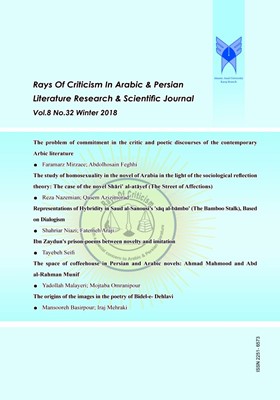The study of homosexuality in the novel of Arabia in the light of the sociological reflection theory: The case of the novel Shāri al-atāyef 'The Street of Affections'
Subject Areas : Literary criticismReza Nazemian 1 , Ghasem Azizimorad 2
1 - Professor of Arabic Language and Literature at Allame Tabataba’i University, Tehran, Iran
2 - PhD Candidate of Arabic Language and Literature at Allame Tabataba’I University, Tehran, Iran
Keywords: Shāri al-atāyef (The Street of Affections), reflection theory, homosexual,
Abstract :
Arabian novel encounters the triple of sex, politics and religion from dramatic and symbolic perspectives, and sees that the politics and religion are the main motivations of sex function, because sex application in Arabian literature has not literary motives, but is a phenomenon that the author uses for the sex own sake or at least must be said that he wants to use sex as a surface property of the body in the novel to have denotative presence in Arabian fiction. thus, it is not possible to explore bodily significations without taking its cultural and social significations into account. Therefore, Ibn bakhit sees a relationship between bodily significations and various problems, among which is his believe that the sex in the fiction is a kind of insurgence against the conventional veil (hijāb) in the society which is in fact a symbol of the veil of thinking. So, we see in this novel only the background (of sex) which can be focal point for the raise of many problems. Therefore, this novel is analyzed on the basis of the sociological reflection theory. The result of the research is that the novelist insists on the homosexuality and illegal relations of all members of the society including children, so that sexual relations are the main motives of the people in this traditional society. The author took Shāri al-atāyef (The Street of Affections) as a statistical society to analyze social disintegration in it. Because this street is the arena of struggles in Arabian society and its everyday social space, as if this street is backbone of Arabian society and the most important place for data processing of network of its social relations.
أن جفرسون، دیفید روبی. 1944م. النظریّة الأدبیّة الحدیثة. ترجمة سمیر مسعود. دمشق: منشورات وزارة الثقافة.
البوعمرانی، محمد الصالح. 2014م. «اختراق المحظور فی الروایة العربیة: بین الحداثة الإبداعیّة والحداثة الاجتماعیّة». مجلة ijhcs، العدد الثالث. صص 64-45
حافظ، صبری. 1981م. «الأدب والمجتمع مدخل إلی علم الاجتماع الأدبی». القاهرة. مجلة فصول. المجلد الأول. العدد الثانی. صص 77-65
الدادیسی، الکبیر. 2014م. تحلیل الخطاب السردی والمسرحی. عمان: دار الرایة للنشر والتوزیع.
الزاهی، فرید. 1999م. الجسد والصورة والمقدّس فی الإسلام. بیروت: إفریقیا الشرق.
عبید، محمد صابر. 2014م. النص الروائی: أسئلة القیمة وتقانات التشکیل. بیروت: المؤسسة الحدیثة للکتاب.
عبید، محمد صابر. 2014م. حرکیة العلامة القصصیة: جمالیات السرد والتشکیل، لبنان: المؤسسة الحدیثة للکتاب.
عزّام، محمد. لاتا. شعریة الخطاب السردی. دمشق: اتحاد الکتاب العرب.
الغذامی، عبدالله. 2005م. حکایة الحداثة فی المملکة العربیة السعودیة. المغرب، الدار البیضاء: المرکز الثقافی الغربی.
فریرة، التوفیق. 2000م. کیف أشرح النص الأدبی. تونس: دار قرطاج للنشر.
فضل، صلاح. 1417ق. مناهج النقد المعاصر. الطبعة الأولی. القاهرة: دار الآفاق العربی.
لحمدانی، حمید. 1991م. بنیة النص السردی. بیروت: المرکز الثقافی العربی.
محفوظ، نجیب. 1947م. زقاق المدق. مصر: مکتبة مصر.
مرادی، محمد هادی وآخرون. 1391ش. «لمحة عن ظهور الروایة العربیة وتطوّرها». مجلة دراسات فی الأدب المعاصر. السنة الرابعة. العدد 16. صص 131-115
مفتاح، محمد. 1990م. دینامیة النص:تنظیر وإنجاز. الطبعة الأولی. بیروت: المرکز الثقافی العربی.
مها، محمد حسین. 2010م. العذریة والثقافة: دراسة فی أنثربولوجیا الجسد. الطبعة الأولی. دمشق: دال للنشر والتوزیع.
النصیر، یاسین. 2010م. الروایة والمکان: دراسة المکان الروائی. دمشق: دارنینوی.
النعیمی، غازی فیصل. 2007م. «تسویق الجسد بین المتعة والجسد الثقافی: مقاربة لروایة خطوط الطول ... خطول العرض». مجلة أبحاث کلیة التربیة الأساسیة. المجلد 6. صص 298-212
وائل برکات، وائل والسید غسان. 1995م. مقدمة فی المناهج النقدیة للتحلیل الأدبی. دمشق: لانا.
ابن بخیت، عبدالله. 2009م. روایة شارع العطایف. الطبعة الثانیة. بیروت: دارالساقی.
_||_


